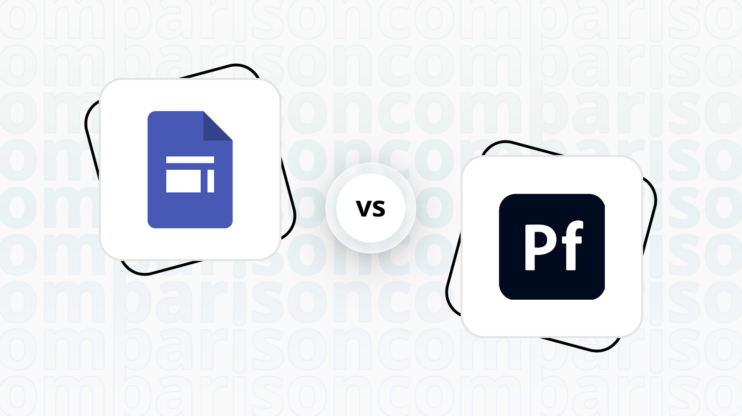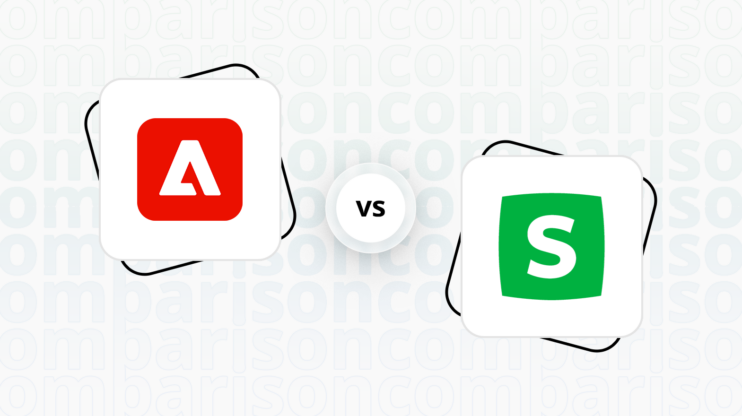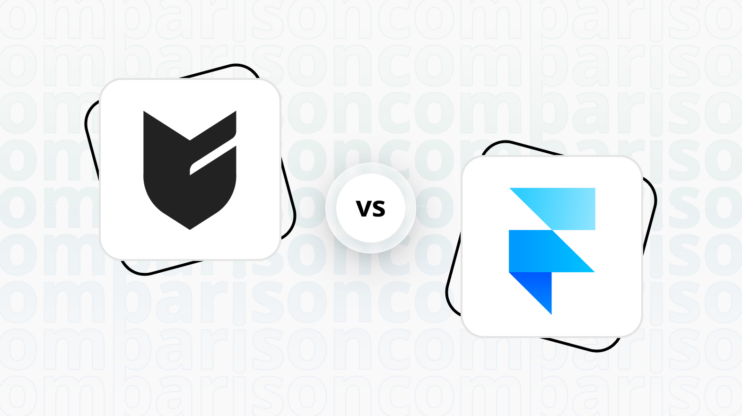Final verdict
Showit and Adobe Commerce(ex Magento) cater to different user needs, each excelling in their respective domains.
-
Showit (Overall Grade: 6.4/10)
is a user-friendly website builder designed for creative professionals. It offers a high degree of customization with its drag-and-drop interface and dual canvas design, making it ideal for photographers, designers, and bloggers. Showit integrates seamlessly with WordPress for blogging, providing a powerful combination of design flexibility and content management. However, its ecommerce capabilities are limited, making it less suitable for businesses focused on extensive online sales. -
Adobe Commerce(ex Magento) (Overall Grade: 6.9/10)
is a robust ecommerce platform designed for scalability and flexibility. It offers a comprehensive set of tools for managing online stores, including AI-driven personalization, multi-channel commerce, and advanced marketing features. Adobe Commerce is ideal for both B2B and B2C businesses looking for a powerful, customizable solution to manage their ecommerce operations. While it has a steeper learning curve and higher cost, its extensive features and integrations make it a strong choice for businesses aiming to scale.

|

|
|
|---|---|---|
|
Design functionalities & templates |
8.5 |
6.7 |
|
Ease of use |
8.6 |
5.4 |
|
Ecommerce |
4.8 |
9.4 |
|
Website Editors |
8.0 |
7.8 |
|
Product testing options |
8.3 |
3.9 |
|
Price |
7.9 |
5.8 |
|
Hosting quality |
7.3 |
8.1 |
|
Website speed optimization |
5.4 |
6.6 |
|
Plugins/extensions and integrations |
5.8 |
9.1 |
|
Marketing features |
7.2 |
8.1 |
|
Customer support |
6.4 |
8.3 |
|
Website security |
8.3 |
8.4 |
|
AI capabilities |
0 |
7.7 |
|
User management |
6.7 |
8.0 |
Best for ecommerce
 4.8
4.8
 9.4
9.4
Verdict
: Adobe Commerce(ex Magento) is the superior choice for ecommerce, offering extensive features and scalability, while Showit is more suited for visually appealing, content-driven websites.
-
Showit
: Showit scores 4.8 in ecommerce, reflecting its primary focus on design and creative freedom rather than robust ecommerce functionalities. It integrates with platforms like WooCommerce and Shopify for basic ecommerce needs, making it ideal for users who prioritize aesthetics and content presentation over extensive online sales capabilities. -
Adobe Commerce(ex Magento)
: With a score of 9.4, Adobe Commerce(ex Magento) excels in ecommerce, providing a comprehensive set of tools for product and inventory management, order processing, customer management, and marketing. Its advanced customization options and integration with Adobe Experience Cloud make it a powerful platform for businesses aiming to scale and optimize their online stores.
Best for informational & business websites
 8.7
8.7
 7.4
7.4
Verdict
: Showit is the superior choice for informational and business websites, offering a user-friendly interface and extensive design flexibility, while Adobe Commerce(ex Magento) is more suited for complex ecommerce needs.
-
Showit
: Showit excels in creating visually appealing, custom websites without the need for coding. Its drag-and-drop interface and dual canvas design make it ideal for creative professionals and businesses looking to establish a unique online presence. With a score of 8.7, Showit is particularly well-suited for informational websites, providing a high degree of customization and control over the website’s appearance on different devices. -
Adobe Commerce(ex Magento)
: Adobe Commerce, with a score of 7.4, is a robust platform designed for ecommerce but can be adapted for informational websites. It offers extensive customization options and scalability, making it suitable for businesses that require advanced functionalities and integrations. However, its complexity and focus on ecommerce features may not be ideal for those primarily seeking to create informational websites.
Detailed comparison
Design functionalities & templates
Design FunctionalitiesRepresents how well each platform allows for creative design and customization of websites.Score Components:
- Template Variety (30%): Range and quality of design templates.
- Customization (30%): Flexibility and options for design alterations.
- User Interface (20%): Ease and intuitiveness of the design process.
- Responsiveness (10%): Adaptability to different devices and screen sizes.
- Innovation (10%): Unique design features and tools.
 8.5
8.5
 6.7
6.7
🏆
Winner: Showit.
Showit offers a wide variety of templates and designs, catering to diverse aesthetic preferences and business needs. Users can choose from an extensive collection that ranges from minimalist and sleek to bold and artistic, ensuring there’s something for every brand identity. The platform is known for its flexibility and user-friendly interface, allowing for easy customization of templates. With a constantly updating library, Showit ensures that users have access to the latest trends in web design, making it a popular choice for creatives and entrepreneurs looking to establish a unique online presence.
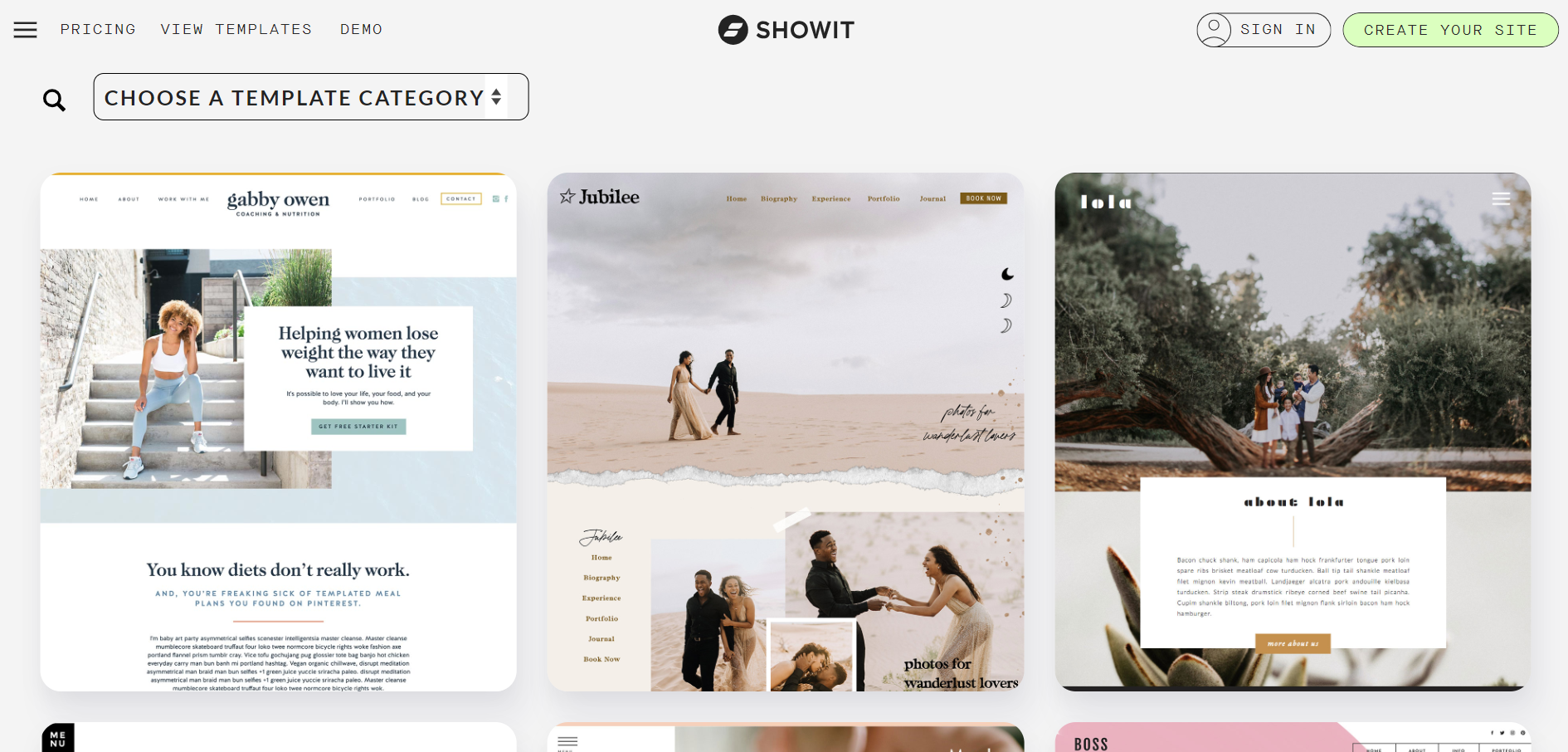

On the other hand, Adobe Commerce, formerly Magento, prioritizes flexibility over pre-built templates. While it offers a limited selection of base themes, users can access third-party themes for customization. Theme options are highly adaptable, allowing changes to layouts, colors, fonts, and the creation of custom page layouts. The platform provides a powerful theme framework for comprehensive control, including frontend editing for basic adjustments. Experienced developers can employ custom code (HTML, CSS, Javascript) for unique designs and advanced functionalities.
Adobe Commerce(ex Magento) Themes
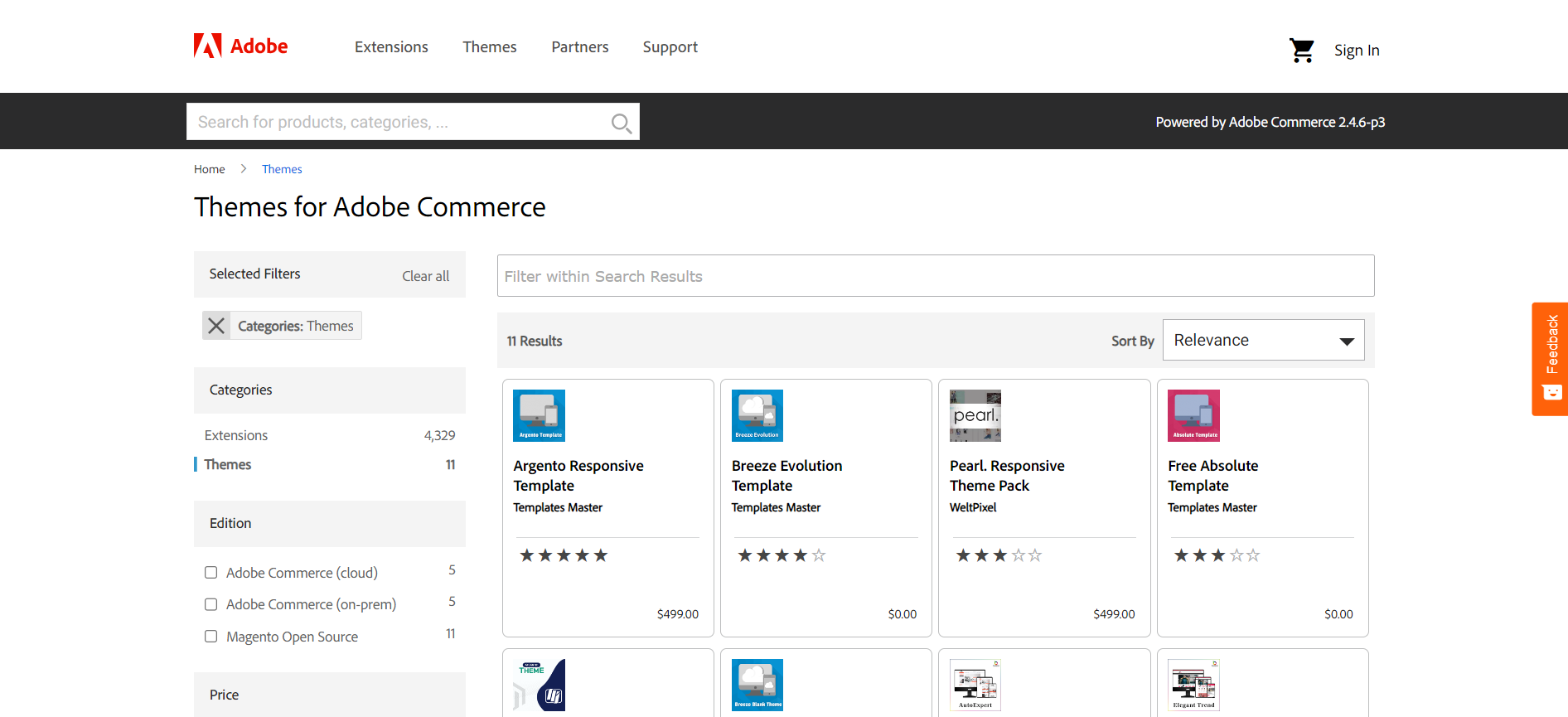
Get a head start on website creation with AI
Create a custom website tailored to your business needs 10X faster with 10Web AI Website Builder!
Ease of use
Ease of useReflects the platform’s overall user-friendliness.Score
Components:
- Learning curve (40%): Quickness and ease of getting started.
- Interface design (30%): Simplicity and intuitiveness of layout.
- User guidance (20%): Quality of tutorials and support.
- Flexibility (10%): Adaptability to various user skills.
 8.6
8.6
 5.4
5.4
🏆 Winner: Showit
. Scoring an impressive 8.6, Showit is a user-friendly website builder designed with a drag-and-drop interface that makes it easy for users to create custom websites without needing any coding knowledge. Adobe Commerce(ex Magento), with a score of 5.4, offers high customization capabilities and scalability but its complexity can pose challenges for beginners without technical expertise.
Learning Resources
🏆 Winner: Adobe Commerce(ex Magento)
. While both platforms offer solid learning resources, Adobe Commerce(ex Magento) provides a comprehensive array of learning resources, including videos, tutorials, and instructor-led courses, covering everything from basic store management to advanced catalog and product management.
For ecommerce
EcommerceMeasures the platform’s effectiveness in supporting online business activities.Score Components:
- Ecommerce themes and templates (20%): Variety and design of templates.
- Product management (25%): Ease of managing and organizing products.
- Payment options (25%): Variety and convenience of payment methods.
- Ecommerce features (20%): Features for managing an ecommerce store.
- Integration (10%): Compatibility with external e-commerce tools and services.
 4.8
4.8
 9.4
9.4
When it comes to ecommerce, Adobe Commerce (ex Magento) is a clear winner with a score of 9.4 compared to Showit’s 4.8. Adobe Commerce is an enterprise-level ecommerce platform offering a comprehensive set of tools designed to assist businesses in establishing and managing successful online stores of varying sizes. On the other hand, Showit is primarily a website builder focused on design, offering great flexibility and creative freedom, making it ideal for visually oriented websites rather than extensive e-commerce platforms.

|

|
|
|---|---|---|
|
Ecommerce themes and templates |
2.0 |
7.5 |
|
Product page customization |
2.5 |
9.0 |
|
Payment processing and commissions |
4.0 |
7.8 |
|
POS capabilities |
1.0 |
7.0 |
|
Payment gateways |
4.5 |
8.5 |
|
Product numbers |
3.0 |
7.5 |
|
Additional ecommerce features |
3.5 |
8.0 |
Showit ecommerce features:
Showit includes basic ecommerce functions but lacks the comprehensive ecommerce features found in platforms like Shopify or WooCommerce. However, Showit allows integration of both the mentioned platforms for enhancing ecommerce capabilities. For businesses prioritizing aesthetics and content presentation over robust online sales functionalities, Showit can be a compelling choice.
Adobe Commerce(ex Magento) ecommerce features:
- Product and Inventory Management
- Order Management
- Customer Management
- Marketing and Promotions
- Payment Processing
- Multi-Channel Commerce
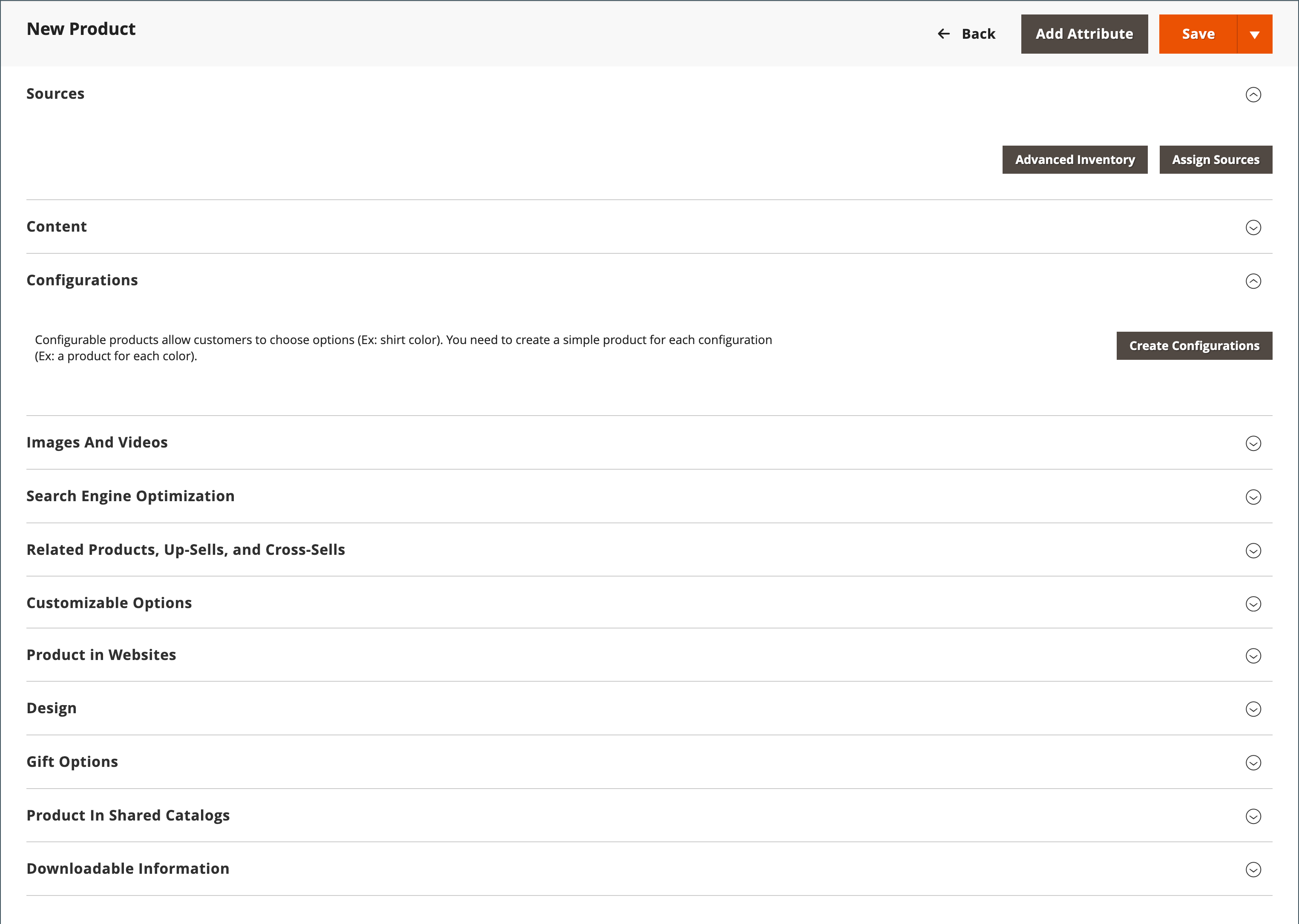
Ecommerce themes & templates
Showit does not have any ecommerce specific templates. On the other hand, Adobe Commerce, powered by Magento, offers a comprehensive ecosystem for ecommerce themes and templates, enabling businesses to customize their online stores to meet specific branding and functionality requirements.
Product page customization
Showit has very basic ecommerce capabilities, primarily through its integration with WooCommerce and Shopify. Adobe Commerce, formerly known as Magento, offers extensive customization options for product pages, enabling businesses to enhance the user experience and tailor product displays to their specific needs.
Payment processing
Showit supports e-commerce by allowing integration with third-party platforms like Shopify Lite, ThriveCart, WooCommerce, and Podia, rather than offering direct payment processing or POS capabilities. Adobe Commerce offers integrated payment solutions and commission management for seamless online transactions, alongside POS integration for omnichannel retail experiences. It supports a wide array of payment gateways, ensuring flexible and secure payment options for customers. These features make Adobe Commerce a versatile platform for businesses aiming to provide a comprehensive and secure shopping experience both online and in physical stores.
Website Editors
Website EditorsEvaluates the platforms’ website building and editing capabilities.Score Components:
- Customization tools (40%): Range and power of editing features.
- Editor usability (30%): User experience within the editor.
- Design flexibility (20%): Freedom in layout and design changes.
- Update and maintenance ease (10%): Simplicity of updating and maintaining the site.
 8.0
8.0
 7.8
7.8
🏆
Winner: Showit
. Showit, with a score of 8.0, is a drag-and-drop website builder designed primarily for creative professionals such as photographers, designers, and bloggers. It offers users the ability to create custom, mobile-responsive websites without needing to write code. Showit’s unique feature is its dual canvas interface, which allows for the independent design of mobile and desktop views, providing a high degree of customization and control over the website’s appearance on different devices. The platform integrates seamlessly with WordPress for blogging, making it a popular choice for users who want the design flexibility of Showit for their site’s look and feel, with the powerful blogging capabilities of WordPress.
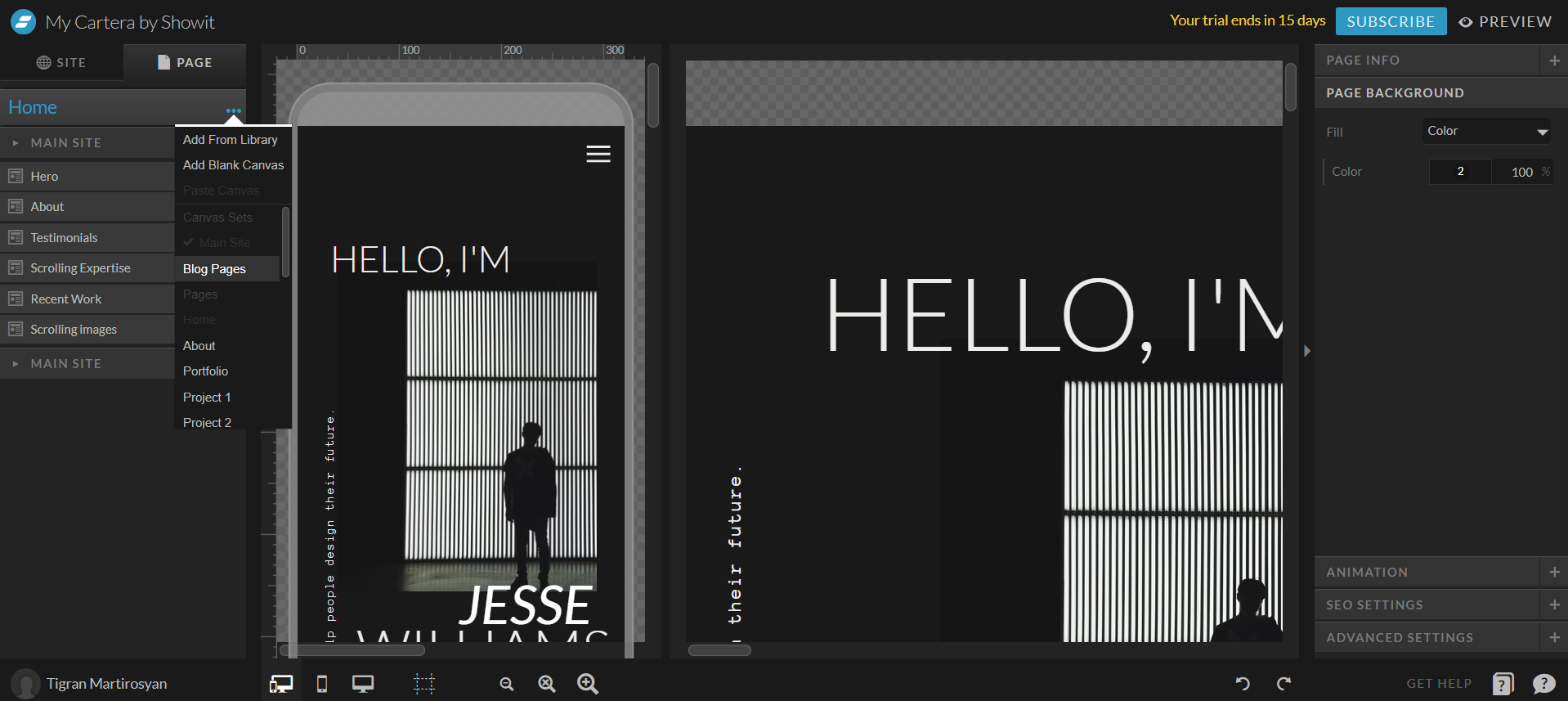
Adobe Commerce (ex Magento), scoring 7.8, is a robust ecommerce platform designed for flexibility and scalability, enabling businesses to create customized online stores with extensive features for product management, customer engagement, and analytics. It supports both B2B and B2C models and offers a range of tools for marketing, SEO, and inventory management, along with a vast ecosystem of extensions. Suitable for businesses of all sizes, Adobe Commerce provides options for cloud-hosting or self-hosting, catering to a wide array of ecommerce needs. However, it does not provide a screenshot of the editor view.
Mobile editor/app
 0
0
 0
0
🏆
Winner: None
. Unfortunately, neither Showit nor Adobe Commerce (ex Magento) offers a dedicated mobile editor or app for website editing. This means that users of both platforms will need to rely on desktop interfaces for website creation and management. While both platforms offer responsive designs that adapt to mobile devices for viewing, the lack of a mobile editor may limit the flexibility and convenience for users who prefer to make changes or updates on the go.
Product testing options
Product Testing OptionsAssesses the options for trying out platform features before commitment.Score Components:
- Trial quality (40%): Extent and usefulness of the trial or free version.
- Feature accessibility (30%): How many features are available to test.
- Trial duration (20%): Length of the trial period.
- Ease of transition (10%): Smoothness of moving from trial to paid plans.
 8.3
8.3
 3.9
3.9
Overall Result
:
Showit Wins
. Showit scores 8.3 in product testing options, significantly higher than Adobe Commerce(ex Magento) which scores 3.9. Showit offers a 14-day free trial during which all premium features can be tested. Additionally, they provide a 30-day money back guarantee. Adobe Commerce(ex Magento), on the other hand, does not offer a free trial or a money back guarantee. However, it is possible to test premium features by requesting a demo version for a trial period.

|

|
|
|---|---|---|
|
Free Plan |
No | No |
|
Trial Duration |
14 days | No |
|
Testing Premium Features |
All features during free trial |
By requesting a demo version |
|
Money Back Guarantee |
30-day money back guarantee |
No |
Price
PriceLooks at the cost-effectiveness and value for money of each platform.Score Components:
- Plan value (40%): What each pricing tier offers.
- Transparency and clarity (30%): Clearness of pricing structures.
- Flexibility of plans (20%): Range of options to suit different budgets.
- Hidden costs (10%): Additional expenses not included in the plan.
 7.9
7.9
 5.8
5.8
Showit offers a range of price plans suitable for different needs, from sites without a blog to high-traffic blogs, with prices starting at $24 per month.
They also offer a custom plan for exceptionally high traffic blogs and custom hosting solutions. On the other hand,
Adobe Commerce(ex Magento) is positioned as an enterprise solution with prices generally starting from approximately $2,000.
They offer two principal pricing structures: Adobe Commerce Pro and Managed Services, designed to deliver scalable, secure, and extensive eCommerce solutions tailored to a wide range of business demands.

|

|
|
|---|---|---|
|
$20-$25 |
Showit ($24/month): Ideal for sites without a blog. Includes 20GB storage and secure certificate. Regular design backups stored for 7 days. Value for price: 6.0 |
No offering at this amount. |
|
$25-$30 |
Showit + Basic Starter Blog ($29/month): For new blogs. Includes everything in the Showit plan, plus blog-specific features. 20GB storage, up to 10k monthly visitors, daily backups stored for 30 days, pre-installed plugins (no additional plugins are permitted), 1 WordPress user. Value for price: 7.0 |
No offering at this amount. |
|
$30-$40 |
Showit + Advanced Blog ($39/month): For migrating or high-traffic blogs with custom plugin needs. Includes everything in the Basic Starter Blog plan, plus up to 25k monthly visits, unlimited number of plugins, unlimited number of WordPress users, Free advanced blog migration from WordPress or Squarespace and FTP access. Value for price: 8.0 |
No offering at this amount. |
|
$60-$70 |
Showit + Advanced Blog 50k ($69/month): Includes everything in the Showit + Advanced Blog plan, with possibility to install custom WordPress plugins, 30 GB storage, up to 50k visitors monthly, and possibility to migrate Squarespace and WordPress blog posts. Value for price: 8.5 |
No offering at this amount. |
|
$100-$200 |
Showit + Advanced Blog 100k ($129/month): Includes everything in the Showit + Advanced Blog plan, with possibility to install custom WordPress plugins, 50 GB storage, up to 100k visitors monthly, and possibility to migrate Squarespace and WordPress blog posts. Value for Price: 9.0 |
No offering at this amount. |
|
$2000+ |
No offering at this amount. |
Adobe Commerce Pro and Managed Services ($2000/month): Adobe Commerce Pro and Managed Services are designed to deliver scalable, secure, and extensive eCommerce solutions tailored to a wide range of business demands. It offers a comprehensive set of ecommerce tools, including product and inventory management, efficient order processing, customer account management, targeted marketing capabilities, diverse payment processing options, robust security measures, and scalability to accommodate business growth. It also offers both self-hosted and cloud-hosted options, providing flexibility and optimized performance. While it does not have an AI website builder, it offers a powerful theme framework for comprehensive control, including frontend editing for basic adjustments. Experienced developers can employ custom code for unique designs and advanced functionalities. |
location. As a result in rare cases the prices displayed here can differ from the ones you see on their
websites.
Hosting quality
Hosting
qualityExamines the reliability and performance of the hosting solutions.Score Components:
- Uptime (40%): Consistency and reliability of website availability.
- Speed (30%): Loading times and performance.
- Bandwidth and storage (20%): Sufficiency of resources provided.
- Data centers (10%): Quality and distribution of hosting infrastructure.
 7.3
7.3
 8.1
8.1
🏆
Winner: Adobe Commerce(ex Magento)
Adobe Commerce offers robust and scalable eCommerce solutions with both self-hosted and cloud-hosted options, providing flexibility and optimized performance. Showit, on the other hand, offers managed WordPress hosting with daily backups and 20GB storage. While both platforms offer reliable hosting services, Adobe Commerce’s flexibility and scalability give it an edge.

|

|
|
|---|---|---|
|
Do they offer hosting? |
Yes, Managed wordpress hosting, with daily backups and 20GB storage. |
Yes, Adobe Commerce offers robust and scalable eCommerce solutions with both self-hosted and cloud-hosted options, providing flexibility and optimized performance through technologies like Fastly Image Optimization. |
|
Data Centers: |
Showit does not disclose any information about its data centers. |
Adobe Commerce on Cloud infrastructure Leverages Amazon Web Services (AWS), Specific data center details not publicly available |
|
Type of hosting: |
Managed WordPress hosting |
Self Hosting, Managed Hosting |
|
Uptime: |
99.9% |
Uptime Guarantee for Adobe Managed hosting is provided |
|
Uptime Guarantee: |
Yes, 99% |
Uptime Guarantee for Adobe Managed hosting is provided |
Website Speed Optimization
Website Speed OptimizationEvaluates optimization of website loading timesScore Components:
- PageSpeed Score (30%): Google’s score indicating performance optimization.
- Loading Time (30%): The average time until a website is fully interactive.
- Mobile Optimization (15%): Optimization effectiveness for mobile devices.
- Resource Optimization (15%): Optimizing images, scripts, and other heavy resources.
- CDN Usage (10%): Use of CDN to enhance speed across geolocations.
 5.4
5.4
 6.6
6.6
🏆 Winner: Adobe Commerce(ex Magento)
Both Showit and Adobe Commerce(ex Magento) have strategies in place for website speed optimization, but Adobe Commerce(ex Magento) takes the lead with a more comprehensive approach including CDN, database optimization, caching, and indexing.

|

|
|
|---|---|---|
|
Focus |
Optimization plugins, Caching |
CDN, Database optimization, Caching, Indexing |
|
Performance Tools |
Not specified |
Not specified |
|
Key Strategies |
Optimization plugins, Caching |
CDN, Database optimization, Caching, Indexing |
|
Load Times |
Varies depending on optimization and website complexity |
Varies widely, dependent on optimization |
|
Page Speed Scores Range |
Not specified |
Scores vary; influenced by plugins, images |
|
Core Web Vitals Improvement |
Not disclosed |
Emphasis on LCP, FID, CLS improvements |
Adobe Commerce(ex Magento) has a comprehensive approach to website speed optimization. It uses a Content Delivery Network (CDN) to deliver content faster to users, optimizes databases to reduce load times, uses caching to store frequently accessed data, and uses indexing to speed up data retrieval. Adobe Commerce(ex Magento) also places emphasis on improving Core Web Vitals, specifically Largest Contentful Paint (LCP), First Input Delay (FID), and Cumulative Layout Shift (CLS).
Showit, on the other hand, uses optimization plugins and caching as its main strategies for speed optimization. However, it does not disclose any information on their Core Web Vitals improvements. The load times and PageSpeed scores for Showit vary depending on optimization and website complexity.
Get a head start on website creation with AI
Create a custom website tailored to your business needs 10X faster with 10Web AI Website Builder!
Plugins and integrations
Plugins and integrationsMeasures the range and effectiveness of additional plugins and integrations.Score Components:
- Variety of options (40%): Range of available add-ons.
- Integration smoothness (30%): Ease of integrating plugins into the site.
- Quality of plugins (20%): Functionality and reliability of the options.
- Custom integration capabilities (10%): Support for custom or third-party integrations.
 5.8
5.8
 9.1
9.1
🏆 Winner: Adobe Commerce(ex Magento).
Adobe Commerce(ex Magento) scores a high 9.1, offering a vast array of extensions and plugins, estimated to be in the tens of thousands, covering aspects such as marketing, payment processing, shipping, content management, security, and optimization. Showit, with a score of 5.8, offers a variety of plugins primarily for users with the Advanced Blog plan, enhancing website functionality across SEO, spam protection, and more. However, the availability and use of these plugins are contingent upon the subscription tier, with higher tiers required for broader plugin compatibility and additional features. Notably, compatibility issues exist with certain WordPress plugins, necessitating alternative solutions or adjustments for optimal functionality.
Adobe Commerce(ex Magento) Applications
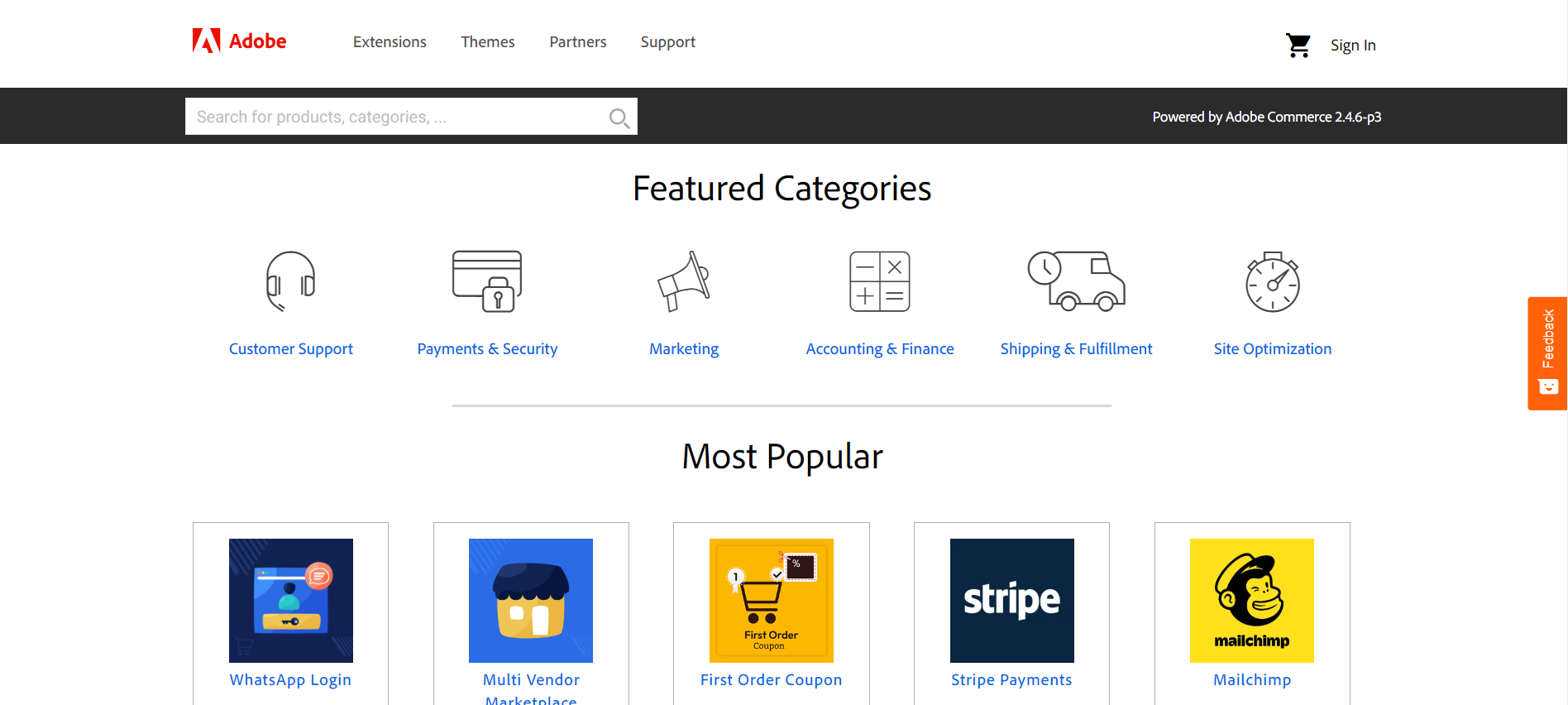
Marketing Features
Design FunctionalitiesRepresents how well each platform allows for creative design and customization of websites.Score Components:
- Template Variety (30%): Range and quality of design templates.
- Customization (30%): Flexibility and options for design alterations.
- User Interface (20%): Ease and intuitiveness of the design process.
- Responsiveness (10%): Adaptability to different devices and screen sizes.
- Innovation (10%): Unique design features and tools.
 7.2
7.2
 8.1
8.1
🏆
Overall Winner: Adobe Commerce(ex Magento)
. Adobe Commerce(ex Magento) stands out for its advanced marketing tools, especially in analytics and ad campaign management. Showit is strong in email marketing and blogging, ideal for content-driven strategies.

|

|
|
|---|---|---|
|
SEO Tools |
|
|
|
Email Marketing |
|
|
|
Blogging |
|
|
|
Social Media Integration |
|
|
|
Analytics and Reporting |
Yes, through integration of Google Analytics |
Adobe Commerce integrates with Google Analytics and other analytics tools, providing detailed insights into your ecommerce activities. |
|
Ads and Promotions |
Yes, through third-party integrations |
Advanced marketing tools for creating and managing promotions, coupons, and personalized content. |
Customer Support
Customer supportEvaluates the quality and availability of support options.Score Components:
- Response time (40%): Speed of support responses.
- Support quality (30%): Effectiveness and helpfulness of the support.
- Availability (20%): Range of support channels (phone, chat, email).
- Resource richness (10%): Quality of self-help and educational materials.
 6.4
6.4
 8.3
8.3
🏆 Winner: Adobe Commerce(ex Magento)
. When comparing Showit vs Adobe Commerce(ex Magento), Adobe Commerce(ex Magento) takes the lead with a higher customer support score of 8.3. Adobe Commerce offers 24/7 support through phone, email, and live chat, ensuring that users can get assistance at any time. Additionally, Adobe Commerce provides a comprehensive knowledge base, community forums, and various support resources such as documentation, user guides, and video tutorials, making it easier for users to find solutions to their problems.
Showit, on the other hand, offers customer support via email and chat from Monday to Friday, 7 AM to 11 PM Arizona Time, with limited support on weekends. While Showit typically responds to messages within 1-2 hours during business hours, it does not provide the same level of round-the-clock support as Adobe Commerce. Showit also lacks detailed information on enterprise-level support, whereas Adobe Commerce offers dedicated account management and access to a global network of experts for enterprise users.
Security
SecurityLooks at the platforms’ security measures and data protection.Score Components:
- Data protection (40%): Safeguards for user and customer data.
- SSL and encryption (30%): Implementation of secure connections.
- Compliance (20%): Adherence to industry security standards.
- Regular updates (10%): Frequency of security updates and patches.
 8.3
8.3
 8.4
8.4
🏆
Winner: Adobe Commerce(ex Magento)
. Adobe Commerce (formerly known as Magento) takes website security seriously, offering a range of measures to protect online stores from potential threats. This includes regular security updates and patches to address any vulnerabilities. The platform also offers secure payment processing and encryption to protect customer data. Additionally, Adobe Commerce provides tools for monitoring and detecting any suspicious activity on the website.
Although it may not offer the same level of specialized ecommerce security features as Adobe Commerce, Showit is committed to maintaining a secure platform for all types of websites. This includes adhering to GDPR guidelines for European customers and employing Amazon’s S3 for secure and redundant data storage. However, Adobe Commerce edges out Showit with a slightly higher security score and more comprehensive security features.
AI Capabilities
AI capabilitiesMeasures the effectiveness of AI-driven features and tools.Score Components:
- Automation efficiency (40%): Impact of AI on streamlining processes.
- Personalization (30%): AI-driven customization for users or customers.
- AI-Assisted design (20%): Role of AI in website design and functionality.
- Data analysis (10%): Use of AI in interpreting user data and analytics.
 0
0
 7.7
7.7

|

|
|
|---|---|---|
|
Personalized Design |
|
|
|
SEO Optimization |
|
AI-driven SEO optimization for content |
|
Customer Behavior Analysis |
|
AI-powered customer behavior analysis |
|
Sales Predictions |
|
AI-driven inventory management and price optimization |
|
Inventory Management |
|
AI-powered inventory management |
|
Content Generation |
|
AI assistance in creating and optimizing site content |
🏆 Winner: Adobe Commerce (ex Magento)
. Adobe Commerce, with a score of 7.7, utilizes AI to enhance the ecommerce experience. Its AI features focus on customer behavior analysis, personalized shopping experiences, inventory management, sales predictions, and content generation.
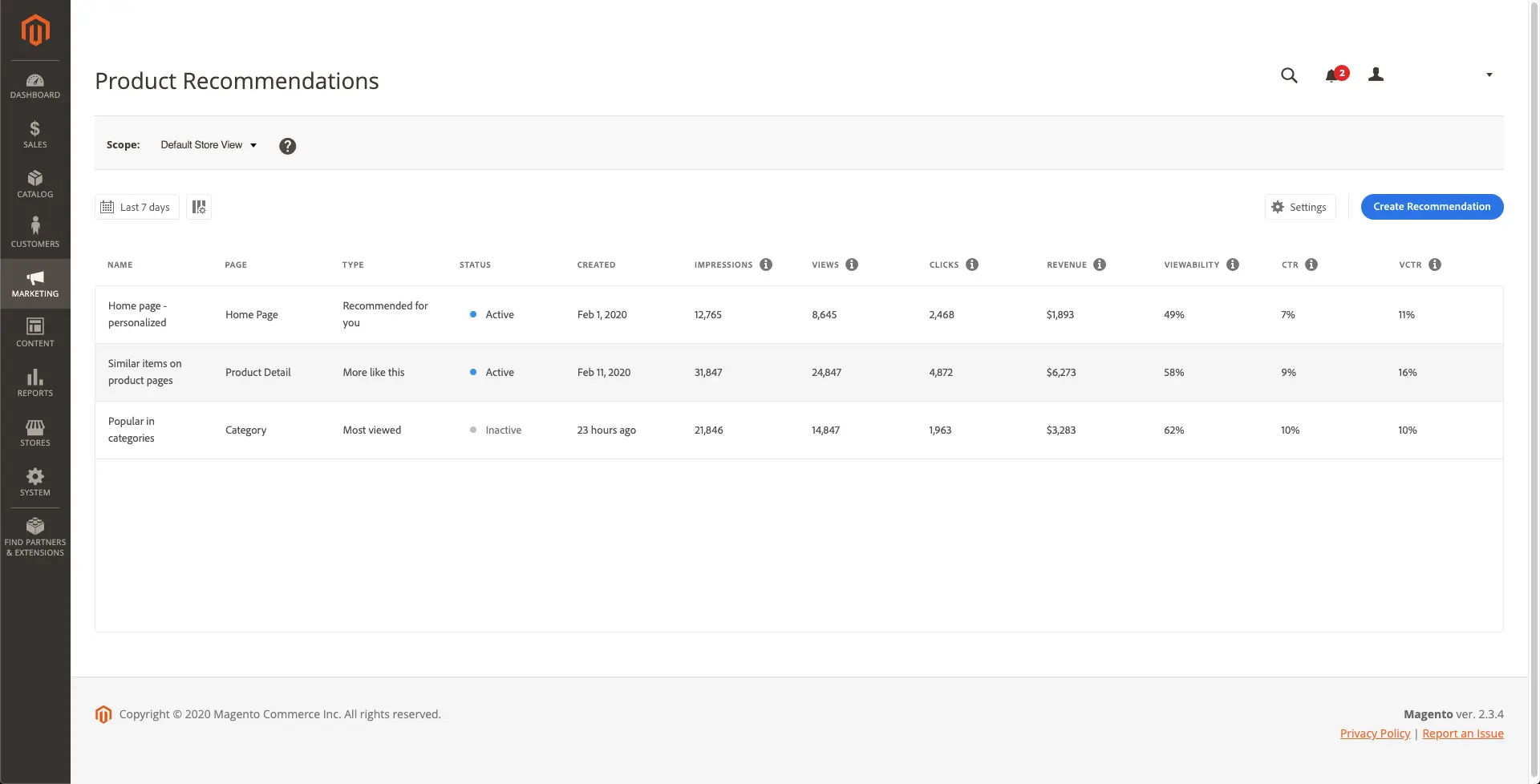
Showit, on the other hand, does not have any AI capabilities. This lack of AI features may limit the platform’s ability to provide personalized experiences and efficient operations, particularly for ecommerce businesses.
User Management
User ManagementAssesses the platforms’ capabilities in managing user roles, permissions, and accessibility.Score Components:
- Role Customization (40%): Flexibility in creating and defining user roles and
permissions. - Ease of Management (30%): User interface and tools for managing users.
- Access Control (20%): Effectiveness of access control measures for different user
levels. - Scalability (10%): Ability to manage a growing number of users efficiently.
 6.7
6.7
 8.0
8.0
🏆 Winner: Adobe Commerce(ex Magento)
. Both Showit and Adobe Commerce(ex Magento) offer different approaches to user management.
- Showit allows only one user on lower plans, on it’s Showit + Advanced Blog plan the platform allows unlimited number of users with different access levels.
- The number of users who can edit an Adobe Commerce website depends on user licenses and roles. User licenses, bought separately, determine the total number of users allowed, with additional licenses purchasable as needed. Roles and permissions, managed within the available licenses, control access and modifications, ensuring data security and efficient workflow.
Showit User Roles and Access Levels:
| Role | Description | Access Highlights |
|---|---|---|
| Administrator | Users with full access to all administration features, including Elementor settings. | Can edit all content, Access to Elementor settings, Can install plugins and themes, Can manage users |
| Editor | Users who can manage and publish content including pages and posts. | Can edit pages/posts created with Elementor, Cannot access Elementor settings, Can manage categories, tags, and links, Can moderate comments |
| Author | Users who can publish and manage their own posts. | Can create posts with Elementor, Cannot edit pages, Limited access to media library, Cannot access Elementor settings |
| Contributor | Users who can write and manage their own posts but cannot publish them. | Can create content with Elementor, Cannot publish or edit pages, No access to Elementor settings, Submissions require review by higher-level roles |
Adobe Commerce(ex Magento) User Roles and Access Levels:
| Role | Description | Access Highlights |
|---|---|---|
| Administrator | Has full permissions to all aspects of Adobe Commerce, including global settings and data. | Full access to all settings, data, and functionalities within Adobe Commerce. Can manage other users’ roles and permissions. |
| Store Administrator | Responsible for the day-to-day management of the store, including products, orders, and customer service. | Access to manage products, process orders, and handle customer inquiries, but may have restricted access to sensitive global settings or data. |
| Design Team Member | Focuses on the aesthetic and user experience aspects of the store, working on content design and layout. | Access to content design tools and functionalities, but restricted from accessing customer, order information, and other sensitive areas. |
| Default User (B2B) | Has view-only access to company profile and credit information, and full access to activities related to sales and quotes. | Full access to sales and quotes activities; view-only for company profile and credit information. |
| Senior Buyer (B2B) | Engaged in purchasing, with access to all Sales and Quotes resources, and view-only permissions to the Company Profile, User and Teams, Payment Information, and Company Credit. | Comprehensive access to Sales and Quotes, with limited viewing rights for company’s financial and profile data. |
| Assistant Buyer (B2B) | Assists in purchasing activities, with permissions to place orders using Checkout with Quote, and to view orders, quotes, and company profile information. | Permission to execute orders and access relevant purchasing data; view-only access to company profile information. |
Additional Features

|

|
|
|---|---|---|
|
SSL Certificate |
|
|
|
Custom Domain |
|
|
|
Free Custom Domain Included |
|
|
|
International Domains |
|
|
|
Mobile Responsive |
|
|
|
Page Speed |
|
|
|
Website Builder Mobile App |
|
|
|
Convert a Website To An App |
|
|
|
Website Analytics |
|
|
|
Multilingual Sites |
|
|
|
Multiple Users |
|
|
User Feedback
Showit is highly regarded among creative professionals such as photographers, designers, and bloggers for its drag-and-drop interface and dual canvas design feature. This allows users to independently design mobile and desktop views, providing a high degree of customization. The seamless integration with WordPress for blogging is another highlight, making it a popular choice for those who want design flexibility combined with powerful blogging capabilities.
Adobe Commerce (formerly Magento Commerce) receives high praise for its comprehensive ecommerce solutions, offering features like customer and order management, scalability, and customization options. Users appreciate its flexibility and ease of use, although some mention a learning curve due to its extensive features. Despite occasional drawbacks like slow speed or complexity, Adobe Commerce proves beneficial for businesses seeking robust ecommerce platforms, aiding in sales growth, customer management, and overall efficiency in managing online stores.
The making of this blog
We followed a clear, step-by-step process to write and research this article.
FAQ
Which platform is better for creative professionals, Showit or Adobe Commerce (ex Magento)?
Can Adobe Commerce (ex Magento) be used for small businesses or is it only suitable for large enterprises?
Is Showit a good option for ecommerce?
How do Showit and Adobe Commerce (ex Magento) compare in terms of user-friendliness?
Which platform offers better customer support, Showit or Adobe Commerce (ex Magento)?
Are there any significant differences in the hosting solutions between Showit and Adobe Commerce (ex Magento)?
Which platform is more secure, Showit or Adobe Commerce (ex Magento)?
Can I manage a multilingual site with either Showit or Adobe Commerce (ex Magento)?












